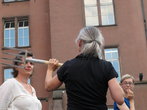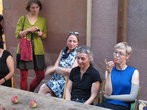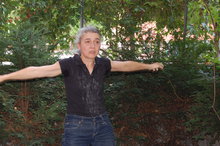Comparison of artefacts of a performance by Dorothea Rust on 2nd September 2011 during the exhibition and mediation project archiv performativ: a model in the Klingental exhibition space, Basel
A) Synopsis of the performance Re-enactment
The point of departure for Dorothea Rust’s performance was a statement she made about her research interest in the model archive. Here, she proposed inquiring into the extent to which the relics of a performance can “together with a short description, text fragments, sketches […] revitalise a memory and trigger new [ideas].”[1]Later on in the statement she defines her concept of relics, which includes all “objects / materials, mostly everyday objects, as they are or modified” which she uses for her performances. Rust sees these objects as “extensions of the body” and her body as an “extension of material”. The objects can have an autonomous character and be bearers of memories at the same time. In concrete terms, the artist based Re-enactment on an eyewitness report of 2008 on one of her own performances in the archive of the Kaskadenkondensator.[2] Referring to this and her own memories and some of the utensils she used at the time, Rust developed a performance for Re-enactment which formed a complex fabric of spaces, times and actions, presence, repetitions and imagined ideas.
The descriptive-interpretative text of the eyewitness report was used on the one hand as a script, as the basis for dramaturgical action. On the other hand, it was used as functional material, as the performer involved it or ‘played on’ it along with other objects and utensils (including green wellington boots, a potato fork, music from a laptop and a sack of apples). By so doing, Rust drew the spatial coordinates of the venue and its various internal and external spaces into the performance and set the audience physically in motion, calling on them to actively take part. The central elements of the approximately 40 minute-long performance were the text read out by the performer, her extempore speaking and her different actions and movements which constantly counteracted the effect of what she said.
B) Selection of artefacts
An audio recording[3] and two series of photographs[4] were selected for analysis from the available artefact types. In view of their media specific characteristics and the different perception and reception processes they trigger, the analysis should focus on their individual qualities and their general informative value which is central to an understanding of the performance. To maintain this focus, I will forego analyses of individual photographs and consider the two picture series as two independent units instead.
The audio recording I made was facilitated by preparatory talks I had with Dorothea Rust. In my role as ‘audiographer’, my experience of the performance was very much determined by the task of registering it on an acoustic level. But thanks to the prior information Rust had given me about the concept, dramaturgy and planned course of actions, I was nevertheless able to move among the audience and remain close to the action when certain activities took place (changes of location, the performer’s movement in space) as I documented.
The two picture series were taken by two different photographers. One photographer was a member of the project team, with whom the task of photographing the performance had been arranged; the other photographer was a spectator, an acquaintance of the artist, who offered to place a number of his photos – the ones he selected as most suitable – at the project team’s disposal.
C) Similarities and differences between the artefacts in view of their intensity of transmission
Since the performer’s voice is clearly audible on the audio recording, it conveys the content of the text she read out and thus an essential conceptual aspect of the performance, namely the reference to one of her previous performances. The nature of the entire event, however, can only be partially appreciated by listening. The discrepancy created by Rust between what she articulates linguistically and her subsequent performative actions, in particular, is only conveyed to a limited degree. For this reason, the event’s specific conception as a re-performance – with its shifts, contradictions and deliberately produced irritations – remains obscure to a large extent. The recording does, however, provide clues about the course of the performance, about certain actions and about the performer’s interaction, or communication, with the audience. Where the formal configuration of the performance is concerned, changes in the performer’s vocal expression between when she is reading out text and when she is extemporising, for example, indicate that Rust was basing actions on a script and that alongside her voice she used various utensils and materials on hand on site. Insofar as the performer’s usage of the objects, or the movements and activities she carried out, generated identifiable noises, the audio recording allows inferences to be made about these. And if the listener factors in Rust’s body as well as her voice, the audible effects of her performative actions (taking deep breaths, breathing heavily with exhaustion etc.) evoke particularly vivid and succinct images of her movements and her physical state. These noises, especially, give rise to a kind of ‘audio-body-transmission’; they are noises which – even without concrete, visually confirmed knowledge of the cause of the physical reactions – listeners can relate to their own experiences and (re)transform into images.
The recording runs the entire length of the performance. ‘Noiseless’ moments give rise to gaps in information which influence the listeners’ subjective sense of time and consequently impede their appreciation of the course of the performance. The ambient sound, on the other hand, allows some inferences to be made about the character of the space; as well as noises (steps, giving information about the nature of the floor etc.) and spoken articulations, it conveys changes in location and hence the performance’s dramaturgical structuring into several parts. Since the recording was made stereophonically, it is also possible to follow the movements of the performer and the audience within the space, further aiding the listener’s spatial awareness and orientation.
The audio recording provides information about the ambient situation particularly when its elements (the size of the audience, audience behaviour, changes between various locations) generate an acoustically perceptible ‘expression’. Audible reactions from the audience (noises and sounds such as laughter or soft talking) evoke ideas of possible events; at the same time they give clear information about the audience’s affective participation. An idea of this participation is also conveyed by the audible ‘pauses for reaction’: the time it takes the audience to carry out the performer’s requests, and the subsequent intensity with which they do so.
Turning to the two series of photographs, I will consider the larger group of 92 pictures first. In terms of content, this picture series conveys information about the individual actions and the utensils which were used and how they were used. In addition, the photographs provide information about the performer’s movements, her location changes and her interaction with the audience. The amount of photos and especially the photographer’s changing position and focus, which becomes apparent (in picture details, perspectives) when the photos are seen in sequence, signalise a certain temporal length; the pictures do not, however, allow any precise inference about the performance’s temporal structure to be made since they do not contain any information about the intervals between individual pictures, or the duration of individual actions. Rather, they offer a contrived visual narrative which – one may assume – outlines the most important moments in the dramaturgical course of the performance. The picture series conveys certain facets of the conceptual structure, such as Rust’s involvement, or setting-in-motion, of the audience and each of the locations of actions. The manner in which Rust (inter)acts with the various utensils and the surroundings is visible on the photos. Furthermore, the photos provide information about the fact that these actions generated certain noises, i.e. they evoke acoustic ideas. The element of re-performance and the reference to the eyewitness report of 2008, which was a determining factor in the concept, by contrast, remain ‘blind spots’, since none of the photos shows the pages of text from a perspective that allows them to be read.
The picture series conveys the dimensions and nature of the spatial situation and allows inferences to be made about the location and context, the time of year, the light situation and other ambient factors. Furthermore, the photos provide indications of the physical (and mental) state of the performer; for example, physical strain and concentration can be read in her facial expression, gestures and posture.
Since there are two picture series of this performance by different photographers, I will briefly summarise the specific qualities of each. While the larger picture series 1 is distinguished by the fact that it tries to capture as many moments as possible and especially to include the audience, the picture composition and formal aesthetic qualities of the second picture series signalises much more of an autonomous interest in each individual picture. Thus the first group allows the course of events in terms of the performance’s content to be appreciated; it comprehensively reproduces the events of the performance – albeit only fragmentarily and from a subjective perspective. The photos of the second group, by contrast, show a visual interpretation of the performance, isolating certain subjectively chosen moments from the course of events. A photographic position can be discerned in these photos which, even during the subjective experience of the action and movement continuum, concentrates on ‘photogenic’ moments or – as the fact of their selection shows – specifically regards such ‘strong’ images as worthy of transmitting.
D) Analysis and transmissions
As described in the synopsis above, two central facets of Re-enactment consist of, firstly, phonetic speech – in the form of sober diction when reading out text, extempore speaking, singing – and, secondly, the content of what is said. When reading out the report, written by someone else, the performer speaks of herself in the third person; she carries out what happened ‘next’ in the previous performance in the words of the eyewitness – and in the process announces what will ‘now’ happen next. In this way, the performer constantly oscillates between two positions. On the one hand, she is the acting, performing agent. This is often reflected in her own articulations, directly addressing the public (such as “Folgen Sie mir bitte! Bitte folgen Sie mir, wo immer ich hingehe” (“Follow me please! Please follow me wherever I go”) or „Ich habe das nicht geübt“ (“I haven’t rehearsed this”). On the other hand, when she reads out text she assumes an observing and describing position – by the objective distance she maintains while she speaks (as reader) and by her own inner-textual presence as a ‘text object’. This presence and her presence as reader do not, however, temporally coincide, since the former lies in the past. The characteristic style of her account, or the manner in which she ‘talks about’ the previous event, shift Rust into a reception situation, aligned with the ‘current’ audience whose impressions she seems to communicate (to them), even though she is in fact transmitting past observations. The moments and action sequences described evoke images in the imaginations of the visitors which are not, however, congruent with the current ‘reality’ – an irritation is generated and the coincidence of the two performances is broken.
It is self-evident that the artefact type of the ‘purely’ audio recording cannot convey a performance’s visual aspects or concrete dimensions of movements and actions and requires no further discussion here. The striking acoustic manifestation of the audio recording on hand here, however, does convey the basic features of the performance’s conceptual configuration and stimulates the individual listener’s imagination: the recording evokes images which, although they are largely not congruent with the events taking place – can be related to the listener’s own experiences and ideas and hence enable each listener to create a subjective, new construction of the performance.
The reception of an acoustic event always factors in spatial and temporal dimensions as well as the physical presence of the listeners. In my opinion, it is precisely these aspects which make the audio recording considered here an interesting document for transcribing the performance Re-enactment. Referring to observations on spatial perception such as Gernot Böhme[5] has set out, Vito Pinto concludes that acoustic phenomena generate an interactive space which “as an aspect of the sonosphere […] broadly overcome the spatial separation of speaker from listener”. And, expanding on these “interspaces”, he writes: “The interspace is determined by the sounding manifestation on the one hand and the physical disposition of the receiver on the other hand. Such ephemeral medial events can evoke certain emotions, associations and memories in the listener. […] Medial spheres are part of the atmosphere, which can stimulate an event or a specific spatial constellation, and at the same time part of the receiver who, with his individual mood or sensitivities, contributes his influence on the ephemeral event […].”[6]
Precisely on account of the specific configuration of Dorothea Rust’s Re-enactment and the lack of ‘visual distraction’, the audio recording generates an acoustic event, the reception of which transmits essential facets of the performance and – as set out above – transcribes them as an independent medial event. Irritation, incongruence, communication and participation are constituent elements of Re-enactment and they are also the elements and themes which are audibly imprinted on the audio recording and which make it an autonomous aural experience.
The ‘audio recording’ artefact type works with individual experiences, subjective sensitivities and, as a result, independent and (re)constructive interpretations, especially on the level of reception. All instances of documentation, including audio recordings, are of course shaped by the attitude and position of and information held by the person recording. Nevertheless this form of authorship in the case considered here has, in my opinion, less far-reaching implications for the artefact and its reception than in the case of other technological recordings such as photographs or video recordings. The photographers, by contrast, are inscribed in their photos as their author; by means of these documents they stylise ‘their’ view of events. Each of the pictures conveys a certain perspective and draws the viewer’s attention to the specific detail in space and time which is focussed on and the picture composition which this generates. In this sense, the two series of photographs considered here each represent an independent, differently configured, visual interpretation of an event. They will have a fundamental influence on future readings of this event and will no longer be separable from them.
Irene Müller, May 2012
[1] Translated from the German: „…zusammen mit einem Kurzbeschrieb, Textfragmenten, Zeichnungen […] vitalisierend zu einer Erinnerung und zu Neuem anstossen [können].“ Dorothea Rust, email of 19.3.11 to Pascale Grau.
[2] The performance in question by Dorothea Rust took place on 5.3.08 in the Kaskadenkondensator, Basel. Cf. Kaskadenkondensator. Saisonrückblick 2007/08, p. 10-11.
[3] Audio recording made on 2.9.11 (by Irene Müller) on mobile recording equipment with integrated stereo microphone, length 38:33 min.
[4] Picture series 1 (92 photos by Pascale Grau); picture series 2 (38 photos by Urs Schmid).
[5] Cf. Böhme, Gernot, „Der Raum leiblicher Anwesenheit und der Raum als Medium von Darstellung“, in: Krämer, Sybille (ed.), Performativität und Medialität, Wilhelm Fink, Munich 2004, pp. 129-140; here, especially pp. 133-135.
[6] Translated from the German: „…als ein Teilaspekt der Sonosphäre […] die räumliche Trennung zwischen Sprecher und Zuhörer tendenziell überwindet […] Der Zwischenraum wird bestimmt durch die klingende Erscheinung auf der einen Seite und die leibliche Disposition des Rezipienten auf der anderen Seite. Solche sphärischen medialen Ereignisse können beim Hörer bestimmte Emotionen erzeugen, Assoziationen und Erinnerungen evozieren. […] Mediale Sphären sind Teil der Atmosphäre, die ein Ereignis oder eine spezifische räumliche Konstellation bedingen kann, und zugleich Teil des Rezipienten, der mit seiner jeweiligen Stimmung bzw. Befindlichkeit seinen Teil zum sphärischen Ereignis beiträgt […].“ Pinto, Vito, „Mediale Sphären. Zur Einführung in das Kapitel“, in: Kolesch, Doris / Pinto, Vito / Schrödl, Jenny (eds.), Stimm-Welten. Philosophische, medientheoretische und ästhetische Perspektiven, transcript, Bielefeld 2009, p. 88.
Audioaufzeichnung
Bilderreihe 2




























































































































